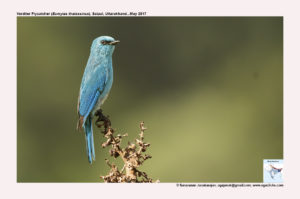Verditer Flycatcher

Verditer Flycatcher Eumyias thalassinus
Etymology:
- Eumyias : Greek word eu- good; muia – fly
- Thalassinus : Latin word for sea-green
Vernacular Names: Pun: Nili tik tiki, Ben: Puthir chitta, Nil-katkatia, Cachar: Dao-tisha lili gadeba, Lepcha: Sibyell-pho, Guj: Piroji makhimar, Harithnil makhimar, Mar: Nelima, Nilang Mashimar Mal: Neelameni
Distribution in India: Summer visitor to North East India and Himalayas and widespread winter visitor.
Description: Size of 15-16 cm, wt. of 15-20g. It is a medium-sized to large, slim, long-tailed, and upright flycatcher. The male of nominate race is almost entirely greenish-blue or turquoise-blue (verditer-blue), with brighter forehead and throat; upperwing and tail brighter cobalt-blue, inner webs of flight-feathers sooty or blackish; velvety black on lowermost forehead, lores and center of chin; pale tips of undertail-coverts; iris dark brown; bill and legs dark grey or blackish. Female is similar to male but slightly duller or greyer, has paler grey lores, with chin and upper throat finely barred greyish. It has an upright stance; flicks tail, most frequently on landing. The juvenile has dull turquoise head and upperparts heavily flecked, speckled or spotted with pale buff, underparts are similar but with larger pale buff to orange-buff spotting. The juvenile female is more heavily spotted buffish and duller on wings and tail than male; wing and tail are like adult adult, with buff tips of greater covert.
Habitat:It is found in open lowland and lower montane forest, including edges, clearings and bushes along streams, edges of cultivation, tall tree groves, also parks and gardens; breeds in Himalayas at 1200–3000 m.
Food Habits:It eats small invertebrates and ripe berries. It is usually solitary or in pairs, occasionally several pairs occupying same area of open forest; also associates loosely with other flycatchers, Ioras, leaf-warblers and Drongos. It is conspicuous; forages from fairly high, open and often exposed perches, including roadside wires, posts and treetops. Actively hawks insects in flight, variably returning to original perch; also flutters in foliage to dislodge insects, and may drop to ground to pick up prey.
Breeding Habits: They breed in Apr-Aug in India. The nest is built by both sexes. The nest is a large open cup of green moss, conifer needles, grass and leaves, placed in holes or crevice in tree trunk or wall, or in epiphytic fern or on ground. It lays a clutch of 3–4 eggs. The incubation and care of young is done by both sexes.